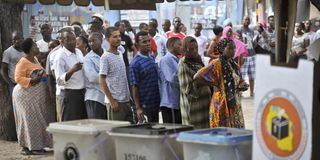Prime
Revealed: 10 key regions in the Tanzania's 2025 presidential election

Tanzanians queue to cast their votes in the presidential election, at a polling station in Dar es Salaam, on October 25, 2015. FILE PHOTO | AP
What you need to know:
- The ten regions—Dar es Salaam, Mwanza, Morogoro, Tabora, Kagera, Dodoma, Tanga, Geita, Arusha and Mbeya—account for 53.73 per cent of all registered voters nationwide.
Dar es Salaam. The secret to winning Tanzania’s 2025 presidential election lies in ten key regions, including Dar es Salaam, Mwanza, Morogoro, Tabora, Kagera and Geita.
While victory depends on nationwide vote totals, these regions carry significant influence due to their large numbers of registered voters, according to the National Electoral Commission (INEC) figures.
The ten regions—Dar es Salaam, Mwanza, Morogoro, Tabora, Kagera, Dodoma, Tanga, Geita, Arusha and Mbeya—account for 53.73 per cent of all registered voters nationwide.
Population impact
Of Tanzania’s 37.65 million registered voters, Dar es Salaam alone has 4.4 million, representing 11.74 percent. Mwanza accounts for 6.02 percent, Morogoro 5.61 percent, Tabora 4.78 percent, Kagera 4.68 percent, Dodoma 4.64 percent, Tanga 4.34 percent, Geita 4.07 percent, Arusha 4.06 percent and Mbeya 3.79 percent.
Political analysts emphasise that high voter numbers are only one factor. Turnout and voter engagement during campaigns will ultimately decide the outcome.
Historical patterns
In the 2020 general election, 29,754,699 voters were registered, but 14,662,746 did not vote, representing 49.27 percent. This turnout was lower than in 2015, when 67.34 percent of registered voters participated.
A Senior Lecturer at the University of Dodoma, Dr Paul Loisulie, says regions with large populations may not guarantee results if voters do not turn out. However, he stresses that presidential candidates must target these areas strategically.
“Regions with many voters can determine election outcomes. Parties that concentrate resources here stand to benefit from the volume of votes,” he said.
Key regions
Dar es Salaam had over 3.1 million registered voters in 2020. It is not only a commercial hub but also a social melting pot with diverse political views.
Mwanza had 2.3 million registered voters and is historically competitive due to its opposition strongholds and CCM’s traditional influence. Mbeya had 1.8 million voters, often considered a stronghold with occasional opposition successes, though CCM has reinforced its support in recent years.
Dodoma, the nation’s capital, had 1.7 million voters, significant given its national political role. Kagera and Tabora each had over 1.5 million voters, regions with considerable influence due to their social and economic structures.
Campaign strategies
A political science lecturer at the University of Dar es Salaam, Dr Matrona Kabyemela, says these regions are critical for candidates to plan voter outreach based on population and local support.
“If a candidate intends to campaign extensively in one area, these statistics show how many voters there are and where they are most likely to support them,” she said.
Political analyst Samson Sombi emphasised that high voter numbers alone are insufficient; effective campaigns determine turnout.
“Candidates must communicate clear, achievable policies. Voters are now informed and influenced by strong campaigns. Even in high-population constituencies, poorly executed campaigns result in low turnout,” he said.
Current preparations
With just nine days remaining before official campaigns begin, parties are actively securing endorsements for their presidential candidates. ACT Wazalendo has started collecting endorsements in Shinyanga, Mwanza and Simiyu, regions known for large voter populations.
In 2020, CCM’s late President John Magufuli won with 12.5 million votes, followed by Chadema’s Tundu Lissu with 1.9 million. At that time, 29.7 million voters were registered; today, 37.65 million are on the voter register, a 26.55 per cent increase.
Political analyst Majjid Salim says disciplined parties will focus on regions with large electorates, starting with voter education and early outreach to ensure visibility.
“Once known, parties should expand influence to all voters in the region, not just members. During campaigns, these areas should be prioritised for maximum impact,” he said.
Salim noted that commercial hubs like Dar es Salaam naturally have large voter populations due to both residents and business activity. He added that while voter numbers indicate potential victory, success depends on how candidates deploy their resources.
Historically, presidential victories have relied on votes from the Lake Zone and other populous regions, where CCM has traditionally concentrated its efforts




